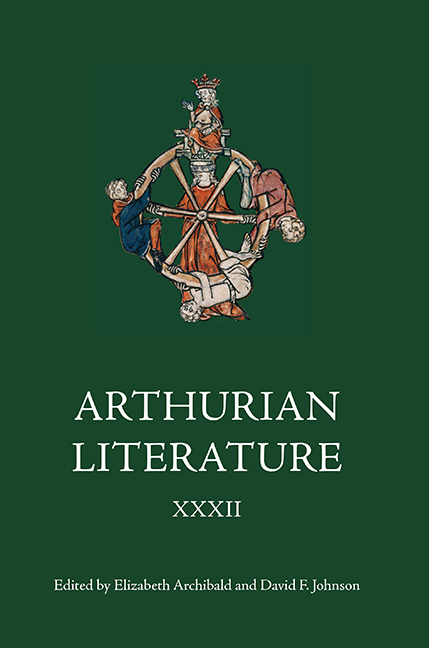Book contents
- Frontmatter
- Contents
- List of Illustrations
- General Editors’ Foreword
- List of Contributors
- I Wounded Bodies: Kingship, National Identity and Illegitimate Torture in the English Arthurian Tradition
- II The Place of Emotion: Space, Silence and Interiority in the Stanzaic Morte Arthur
- III Another Source for Malory’s ‘Tale of Sir Gareth’
- IV ‘Warre and Worshyppe’: Depictions of Battle in Malory’s Le Morte Darthur
- V Malory’s ‘Chivalric Cliques’: Public and Private Felyshyp in the Arthurian Community
- VI Scribal Modifications to Concluding Formulae in the Winchester Manuscript
- VII Heraldic Imagery in the Embroidered Tristan Narratives
- VIII Update to the List of Manuscripts of Geoffrey of Monmouth’s Historia Regum Britanniae
- Contents of Previous Volumes
IV - ‘Warre and Worshyppe’: Depictions of Battle in Malory’s Le Morte Darthur
Published online by Cambridge University Press: 11 May 2021
- Frontmatter
- Contents
- List of Illustrations
- General Editors’ Foreword
- List of Contributors
- I Wounded Bodies: Kingship, National Identity and Illegitimate Torture in the English Arthurian Tradition
- II The Place of Emotion: Space, Silence and Interiority in the Stanzaic Morte Arthur
- III Another Source for Malory’s ‘Tale of Sir Gareth’
- IV ‘Warre and Worshyppe’: Depictions of Battle in Malory’s Le Morte Darthur
- V Malory’s ‘Chivalric Cliques’: Public and Private Felyshyp in the Arthurian Community
- VI Scribal Modifications to Concluding Formulae in the Winchester Manuscript
- VII Heraldic Imagery in the Embroidered Tristan Narratives
- VIII Update to the List of Manuscripts of Geoffrey of Monmouth’s Historia Regum Britanniae
- Contents of Previous Volumes
Summary
Critical analyses of battle scenes in Le Morte Darthur focus on Malory's treatment of warfare as chivalric combat. Helen Cooper concludes, for example, that Malory's battle scenes constitute ‘a test of prowess, named knight against named knight’ to confer ‘renown’; Kevin Whetter writes that ‘Malory […] presents combat, whether on a great or small scale, as an opportunity to win worship.’ Certainly, battles in Le Morte Darthur are opportunities for knights to win chivalric renown, as they were in real life; Richard Kaeuper designates prowess as the essential element of chivalry, and of course warfare offered the greatest opportunity to demonstrate deeds of arms. However, while acknowledging the centrality of prowess, Maurice Keen points out that chivalry was conceived of differently at different times and places in the Middle Ages. Likewise, while Malory's narrator always praises noteworthy deeds of arms, depiction of battle varies as different aspects of chivalry are emphasised. Early and late in Malory's narrative, battles are summarised in the most laconic of chronicle styles. At other times, Terence McCarthy has commented, ‘Modern readers […] frequently lose patience […] with [Malory’s] battle descriptions’, which he calls ‘a wearisome catalogue of military events’ filled with ‘repetitive detail’ (a reaction shared by Mark Twain). In some battles, combatants are individually named and described, as Helen Cooper remarks, and fight in ‘opposed pairs’, as Andrew Lynch points out; in other cases, such as in the Battle of Bedgrayne, some knights are named but fight in groups of nameless mounted enemies. Lynch has noted that in English Arthurian literature ‘narratives of war’ are often a means of portraying ‘the changing representation of military power, political organisation and the right to rule’. I intend to argue that a detailed analysis of battle scenes throughout the work reveals the conceptual layers of chivalry in Malory's romance and illuminates what, for Malory's audience, chivalry meant not just for a knight but for a king.
Uther's Wars
The first battles in Le Morte Darthur are those conducted by King Uther against rebellious subjects. These are narrated tersely in a style more reminiscent of contemporary fifteenth-century chronicles than of Malory's French source, the Post-Vulgate Merlin, but hint at elements of description that will become common in the battles of Uther's son Arthur.
- Type
- Chapter
- Information
- Arthurian Literature XXXII , pp. 75 - 104Publisher: Boydell & BrewerPrint publication year: 2015



